Boston - Seat of Revolution
Saturday 29th April (London Heathrow to Boston Logan International)
After a 7 hour flight across the Atlantic in what was a very pleasant, but uneventful flight, I finally touched down in Boston, the capital of the US state of Massachusetts.
Now for anyone visiting the US, you should know that in the past, the one thing that people always dread is the time spent at passport control. Some claim to have spent over an hour waiting for their turn to speak to the border official as the line of passengers slowly meanders its way to the front. This time however, I was in for a surprise …
We landed at around 7.35pm local time and by roughly 8pm I was already dragging my heavy bag from the conveyor belt. The whole time at passport control was a matter of me staring into a camera while providing a scan of the fingers of first my right and then my left hand. Gone were the questions about where I was a member of the communist party or whether I had anything on me that could cause a nuclear explosion. Instead the border official looked at my documents, looked at me, looked at my documents again and then waved me through with the words “Welcome to Boston!”
I must admit, I did indeed immediately feel right at home when I got outside the terminal … because I walked straight into a downpour! Boston had had a spell of rain the last couple of days, but I had hoped that this would be an aberration and that my few days sightseeing would be spent trying to stay as dry as possible.
I quick taxi ride and I was checking into my hotel in downtown Boston. The concierge checked me in, advising me of the breakfast times for the following day and then wished me a good night as she directed me up to my room on the ninth of nine floors. On my way to the room I passed an indoor pool which was in use even at 9pm in the evening. My room was larger than I had expected and so I set about unpacking and gathering the things I would need the next day. The day had tired me out and so it took no time at all for me to drift off to sleep.

Sunday 30th April (First Day Boston - Harvard and Ghost-Hunting)
I awoke somewhat abruptly the next morning, having forgotten to change the alarm settings of my travel clock. 6.30am was a little early to wake up, but I soon discovered that this was rather fortunate. Heading down to breakfast, I found only a few tables occupied and the breakfast room fully stocked. The hotel had advertised a continental breakfast and the did not disappoint. Scrambled eggs, beef patties, french toast, several forms of bread rolls (including my favorite, bagels) were available for selection as were various iterations of cereal. Jams and other spreads were also available as was a waffle maker in case anyone fancied to “make their own” to eat.
The bad weather had not abated. On the contrary, my first day in Boston would be a wet one, so getting back to my room I unpacked my bag to get my emergency poncho just in case the weather turned really nasty later on. I then set about looking for the most convenient route to get to my first excursions meeting point, Harvard Subway Station in Cambridge, Massachusetts. The number one bus route seemed the quickest way and so I checked the time I needed to depart before setting out to explore the local area.
Indeed, my selection proved to be correct as in no time I had reached my destination. With time to spare I explored the nearer environs of the university and its many faculty buildings before making my way to the designated meeting point where our guide Alma was already waiting, doing her level best to keep out of the driving rain. Alma explained that she was. First Year senior studying government and architecture. It has to be said that it is not unusual for students to study seemingly unrelated courses to begin with only to specialise in one or two courses in their second and third year. Many students supplemented their incomes either by working as tour guides or running the various Harvard Shops dotted about the campus. It was clear from the start that this was not Alma’s first rodeo as she spent over an hour enthralling us with her knowledge of the university, its varied history and showing us the many important sites around campus.
The university is the oldest institution of higher learning in the United States. It’s motto is “Veritas” which is of course the Latin for “Truth”. Near the Founder”s gate stands a statue with an inscription that reads “John Harvard - Founder - 1638. This statue is also known as the statue of three lies.

First, John Harvard was not the founder, he was merely a benefactor who bequeathed the institution a large sum of money and and extensive library of over 400 books. Second , the college was founded in 1636, not 1638. And third, that is not John Harvard, but a student named Sherman Hoar who stood model for the sculptor. One can barely see that the statue’s left foot is shinier than the rest of the statue and this is the result of students rubbing it liberally over the years due to the ongoing belief that it would bring them success and good fortune.
Today the university houses near to 23,000 students, roughly 20% of which come from overseas. It’s faculties include amongst others law *economic, property and criminal), medicine (surgery, dentistry, etc) and business. Over the years it became common to rename the houses on the main campus after the presidents of the university and so we have buildings like Eliot, Dunster, Leverett Lowell, Mather, Quincy and Winthrop House. However, one such president was denied the honour of having a house named after him because of his name. The man in question was Peter H-O-A-R. I’ll leave it to the reader to fill in the blanks.
One last bit of trivia about Harvard was that it did not become effectively co-ed until World War II. Before than men and women would be taught separately. Professors would teach the male students in the mornings and then teach classes at the all-female Radcliffe College in the afternoons. The college had been formed in 1879 but adhered to strict Victorian standards of decorum and etiquette. Having men and women in the same class was not considered seemly and so the aforementioned compromise was reached. Even after they classes included men and women, the latter would still only graduate from Radcliffe College and not Harvard until the acquisition of the college by Harvard ended the segregation once and for all in 1979.

On my journey back from Harvard, I chanced upon a road sign that made me hop off the bus almost as soon as I had got on it. Here stood the Massachusetts Institute of Technology or M.I.T. as it is more commonly known. The institute was chartered in April 1861, its faculties designed to emphasise independent research organised around seminars and laboratories as established by the German research faculty model. However, two days after its launch saw the begin of the American Civil War as the soldiers loyal Conderate States fought 4 years of bloody war against the troops of the Union. This of course only ended with the surrender of General Robert E. Lee to the later president Ulysses S. Grant at Appomattox courthouse in 1865. Only then would MIT be able to hold its first classes and seminars.
Over the centuries, the Institute resisted 6 attempts to merge with its much larger neighbour. The closest they came was in 1917, when the merger had been all but agreed on paper, but the Massachusetts Supreme Judicial Court ruled against the proposal following waves of protest among the student body and beyond. Today, MIT boasts a contingent of nearly 12,000 students studying subjects from computer science, robotics, Defense (deliberately spelt the American way) and several branches of medicine.
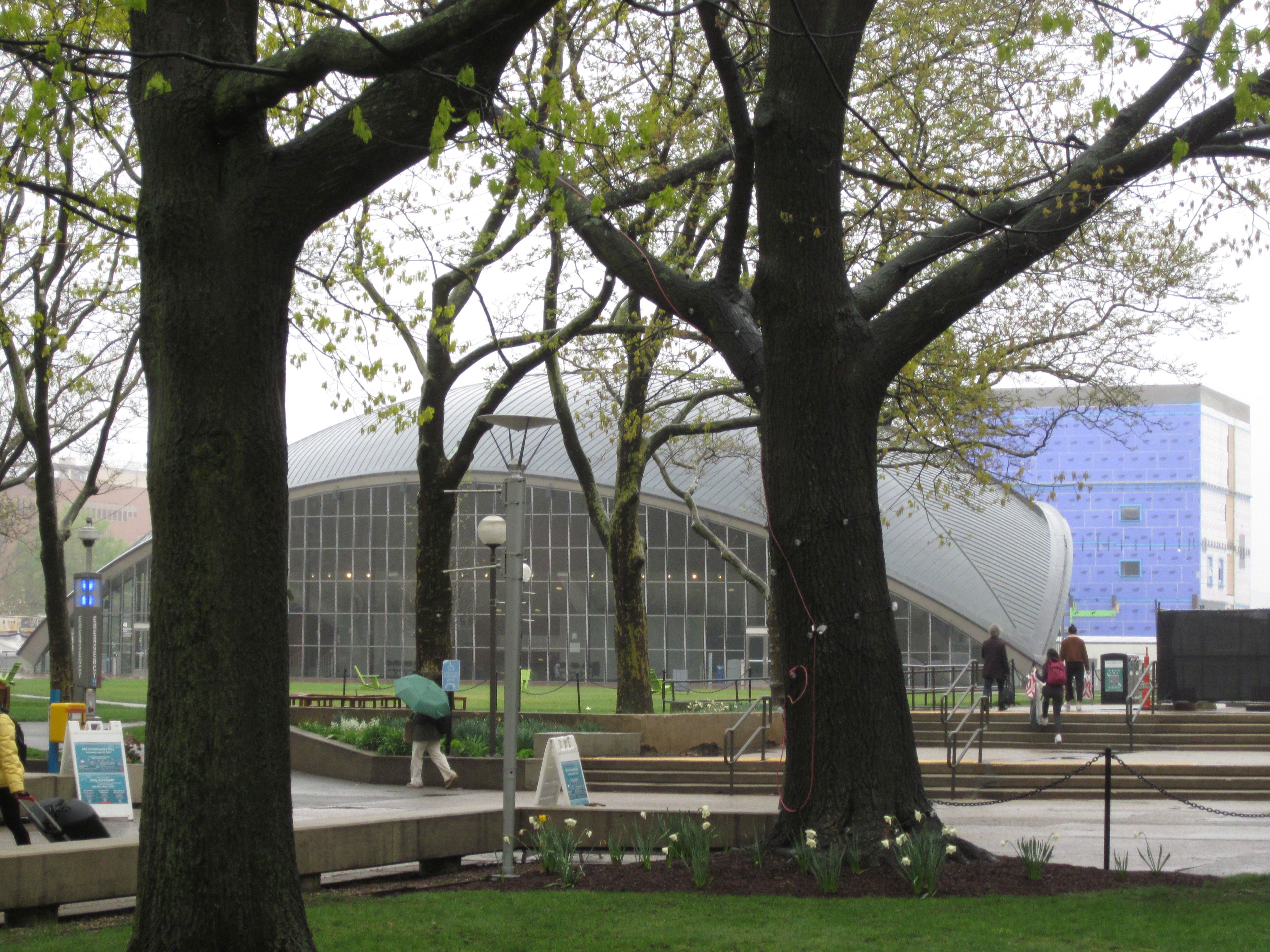
Separated from the mainland of Boston by the Charles river, Cambridge houses some of the brightest minds in the world and has several famous alumni: Starting with MIT: Kofi Annan, the first black United Nations Secretary General, Buzz Aldrin, the second man to step foot on the moon and Richard Feynman, one of the scientists involved in the Manhattan Project, the invention of the atomic bomb that levelled Hiroshima and Nagasaki in 1945 forcing the surrender of Japan in World War II.
Harvard too has seen some now famous figures grace it’s hall of learning: Michelle and Barack Obama, Mary Robinson, the first female president of Ireland and Janet Reno, the first female US Attorney General. The acting world is well represented also with Dolph Lundgren being an MIT alumni while Tommy Lee Jones went to Harvard next door. No wonder then that the Charles river is also known as the smartest river in the United States.
There was just enough time for me to get back on the bus and go back to my hotel to jot down some notes about what I had learned and then get kitted out for my night time adventure, looking for ghosts and spooky apparitions. Boston’s colonial past made it a hotbed for paranormal activity and this wa one experience I could not pass upon, rain or no rain.
Ok, cards on the table, I do believe in the paranormal. When you are born on Friday 13th, it is hard not to. I try to avoid going under ladders, I do not open an umbrella indoors and while I like cats in general, I try to void black ones. It may sound strange to the reader, but if I couple this with the fact that I also suffer from OCD, this behaviour should seem less odd on the whole. So after checking that the key card was in the security pocket of my wallet for the forth time and having checked the contents of my shoulder bag equally so, I set out into the drizzle and to the nearest bus stop. 30 minutes later and I had reached my destination, the statehouse with its gold dome. Now in the dark, this was hard to see, the driving rain lashing against my face. It was time to get out the poncho and so slipping it over my clothes I looked like a reject from Glastonbury.

After a few minutes, my guide turned up, dressed for the weather and anxious to get the tour started. There were 7 people scheduled to join us. None did so! That’s right, I got my own private ghost tour with a very knowledgable guide called Julia who introduced me first to the statue of Mary Dyer, a Quaker woman who, having returned several times to the city to preach her revisionist religious beliefs was eventually hanged on Boston Common. It is said that her ghost appears on the common with her hands outstretched, still calling on people to forgoe their puritan ways. Other notables include Rachel Ward, a woman of irish decent who was hanged as a pirate at her own request, rather than as a common thief.

Over the course of the next hour, I learned about the ghostly goings on in the so-called Parker House, a hotel haunted by amongst others its former owner, and where shoes and money discarded wantonly in the evening were found neatly stacked and arranged the next morning. The tour ended with the tale of the haunted ships-figurehead which not only caused two ships that bore it to either run aground or to split in two pieces on their maiden voyages, it also saw the old town hall which it was stored in afterwards to catch fire. Only an eagle-eyed watchman prevented the fire from getting out of control.
By now, the rain had somewhat abated so that I could make my way back to the bus stop without looking like a visitor from Outer Space. Tomorrow, would be a long day with several sites through the city, culminating in my favorite American past time, but more about that later. Time to hit the pillow …
Monday, 1st May - Fake News, Independence and Altar Worship.
After the day before, the sun finally decided to show its face, hiding it only occasionally to allow for some light rain and drizzle. Today, I was on the trail of the men whose actions lead to, though not necessarily caused the War of Independence and Colonies break with England in the late 18th century. I was about to follow the so-called “Freedom Trail”, a line that looks like a piece of morse code and following which, you can visit the various sites connected to the path to independence. Our guide, dressed in appropriate colonial attire, introduced himself as “Samuel Grey”, a rope maker living in Boston in the 1760s until his death in 1770. He regaled us with stories of what colonial Boston was like, how it came to the revolution and subsequent war for independence and who were the people involved.

‘Samuel Grey” (his real name being “Jeff”) told us that the event most commonly thought to have started the war was the so-called Boston Tea Party, but in reality, the real build up to this conflict occurred years earlier with the so-called Boston Massacre of 1770.
Tensions had been running high in the city with the British forces camped out and what today is Boston Common. Dwarfed by the 16,000 colonists, the soldiers had the unenviable task of not only keeping order but also to protect the tax collectors dispatched by the English King George III. It was not the fact that they were made to pay taxes to a far off ruler that enraged the colonists however, but the fact that they were given no voice in how the money was spent.
The cry of “no taxation without representation!”, became a rallying cry to the colonists. It is said to have started by James Otis in the 1760s, a sort of poacher turned gamekeeper, one could say. Otis worked as a prosecutor for the British authorities until switching sides in protest against the so-called “Writs of Assistance”. These efffectively gave the soldiers authority to enter the colonists’ homes without the need for the search warrant. To this Otis said “a man’s house is his castle!”, arguing that this law was an intrusion into a citizen’s privacy. Otis is buried with several others in the Old Granary Burial Ground near Boston Common.

In the lead up to the “massacre”, a colonist attack on a royal sympathiser had lead to the unfortunate death of a child, after the shop owner fired a shot through his window in an attempt to disburse the crowd. This was the followed by a series of dock fights between colonists and British Army personnel, setting the stage for the event that was to come.
On the night of 5th March 1770, a lone soldier was guarding the customs house when he was first verbally, then later physically assaulted by some local youths, causing him to cry out for assistance. This then brought a company of soldiers under the command of Captain Thomas Preston to his aid, but by that time, the bells of the city had rung out and more and more colonists headed towards the customs house. Some had come to cause trouble, others to try to ensure that nobody took any action they would regret. Unfortunately in the all the confusion and th heated blood between the two sides, someone shouted “Fire!” and one of the soldiers discharged their rifle, leading to others doing the same.
By the end of the night, five colonists lay dead in the snow. Among them were our story teller Samuel Grey and Crispus Attucks, one of few free men of color in the city. They too lie buried in the Old Granary Burial Ground were a stone Tablet marks their final resting place.

The soldiers including Preston were all charged with murder and it was only thanks to an impartial jury of non-Bostonians and the arguments for the defence presented by none other than John Adams, later president of the United States, that they were cleared of all wrong doing. Still the touch Paper for insurrection had been well and truly lit and it would not be long for the next historic event to charge tensions even further. While any loss of life can be considered a tragedy, the death of 5 people does not equate to a massacre, but the term was propagated by the likes of Samuel Adams, John Adams brother, to further incite tensions between the colonists and their British overlords. So, in sense one could say that “Fake News” or “Alternative Facts” has been around for a lot longer than we realise!
While the customs house no longer stands, the old town hall it stood opposite surely does and remains an iconic feature of Boston”s colonial heritage to this day.
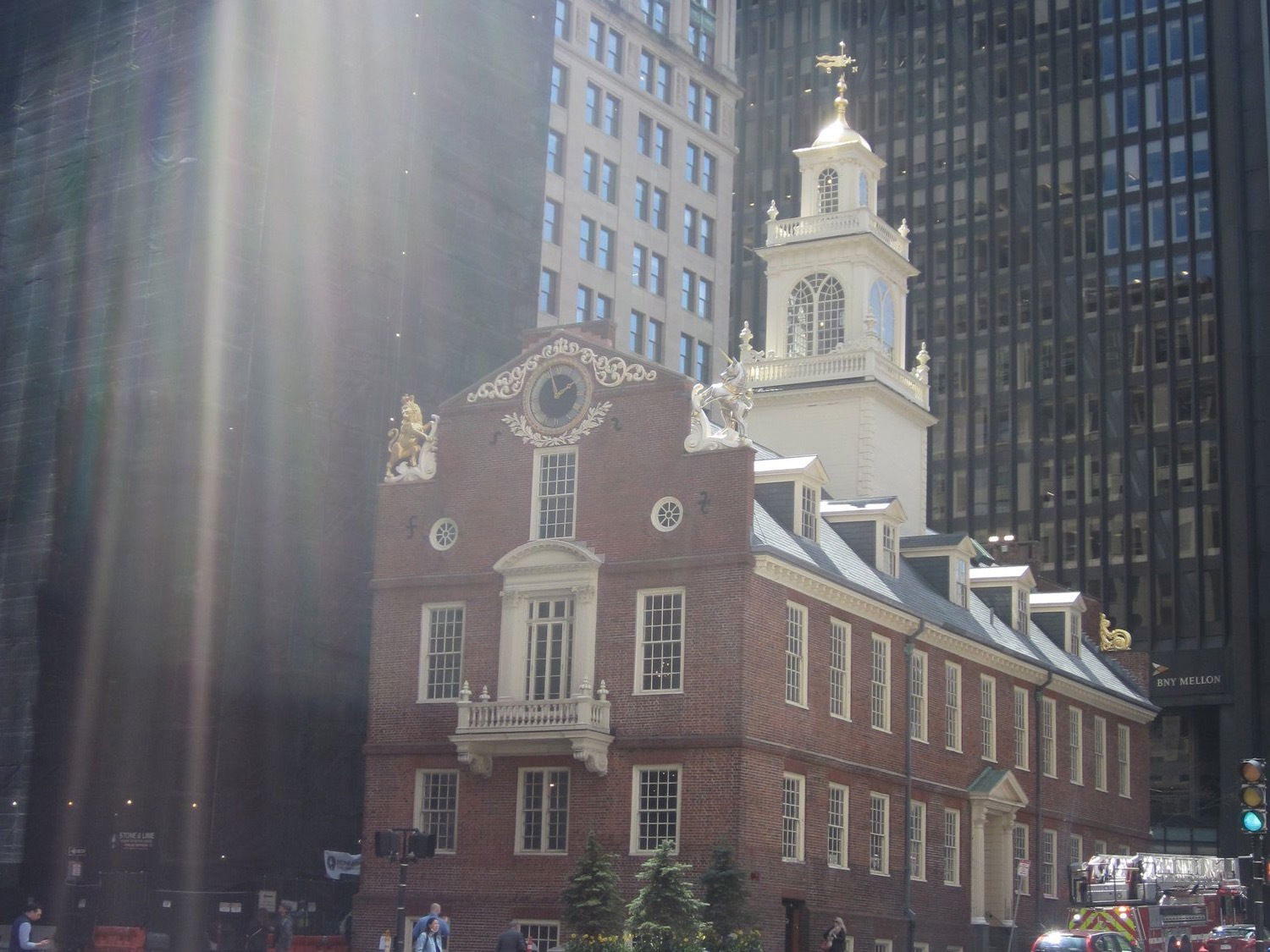
The year is 1773. In response, to the “massacre” at the Boston customs house, Britain had revoked all but one of the taxes imposed on the colonists, the tax on tea. Any tea imported into Boston by the British East India company was subject to an import tax. The colonists meanwhile had gotten around this tax by smuggling in tea from Holland or other far flung places not controlled by the British East India company and this was threatening the company’s very existence. As a result, the Tea Act was imposed in May 1773 allowing the company to sell tea to the colonies without paying duty but still required the payment off the tax when the goods were taken on shore. This enraged the merchants who had profited well from the tea-smuggling operations, because now even smuggled tea was more expensive than the tea from the British East India company.
Enter the Sons of Liberty. Formed years earlier by men like Samuel Adams, John Hancock and most notably a Boston silversmith by the name of Paul Revere, they organised a vote to refuse the import, storage or sale of the tea that had landed on three vessels in the harbour, the Datmouth, the Beaver and the Eleanor, all laden with crates of tea from China. When the colonial governor refused to compromise with the colonists, setting a deadline on when the tea had to be taken off the ship, the stage was set for what was to become known as the Boston Tea party.
On the night of 16 December, the Sons of Liberty, disguised as Native American clothing and armed with Bows, Knives and Tomahawks first boarded and then proceeded to dump the 342 crates of tea into Boston harbour. At today’s prices, the tea would have a value of over 1 million dollars. Little wonder then, this this though non-violent act did not go unpunished. King George III imposed the coercive acts which amongst others closed off the harbour to all trade until the tea had been paid for in full. However, it also imposed martial law on a city growing increasingly resentful of the interference and punitive control by a far flung monarch. If the coercive acts were meant to quell rebellion, they archived the exact opposite. Now it was just a matter of time before Boston would seal its place in American Revolutionary history.
After the Boston Tea party, colonists became increasingly wary of British troop movements. In a surprising echo to today where many people fear that the government is coming for their guns, in the mid 1770s, this was indeed a legitimate concern. Worried that the colonists were stockpiling arms to use against them, the British forces attempted to capture these guns from the towns of Concord and Lexington to the north of the city. However, like today, such plans were not made and then carried out immediately. Instead, the British strategised for two weeks on their plans, discussing them openly among their family and servants. Several of these were by then spies for the Sons of Liberty and this gave the colonists time to prepare for the British arrival. The night the soldiers did set off was captured by the poem “Paul Revere’s Ride” written in 1863 by Henry Wandsworth Longfellow. Whether it was the fact that almost 100 years had passed since the event he was writing about, or because the truth was less exciting, Longfellow’s account is largely a work of fiction!
Anyone who wants to read the poem can do so here: “ https://www.allenisd.org/cms/lib8/TX01001197/Centricity/Domain/1919/The%20Ride%20of%20Paul%20Revere.pdf“. In no particular order then. Only a fool rides through the dead of night shouting “The British are coming!”. First, in those days, both colonists and the red coated soldiers were “British” and second shouting anything in the middle of the night was likely to get you shot! Second, Paul Revere never made it to his destination, he was captured before he got there. The fact that the message still got through was due in part to a Reverend Prescott who chanced upon Revere and another rider, William Daws, while returning from an evening with his mistress. He was the only man to make it through to the raise the alarm. This then lead to scores of other riders fanning out in all directions spreading the news like wild fire and ensuring that by the time the British soldiers got there, both Lexington and Concord were effectively gun-free, frustrating the colonial governor and fermenting the belief that a rebellion was close at hand.
Whether it was or not is now a matter for debate, because what really began the American War of Independence was a chance encounter between a group of Minutemen or colonial militia led by Captain John Parker and a column of British troops near the town of Lexington on 19th April 1775. In spite of orders on both sides not to initiate any hostilities, a shot was fired, quickly followed by more shots from both sides. Having initially retreated, the Minutemen succeeded in driving the British back to Boston. That first shot was to become known as “the shot heard around the world”, though it has also been associated with the assassination of Archduke Franz Ferdinand of Austria by Gavrilo Princip in 1914 which started the First World War.
Okay, lets talk religion! Now, before you leave, skip the page or think where the heck is this coming from, I thought Mike was an atheist, it is not what you think! Technically, like a growing number of people in the world I define my belief as “Jedi” but that is not important right now! Fact is, there is more than one type of worship and for a town like Boston, it centres around a group of men who embody and represent the rebellious spirit of the city. I am of course referring to the city”s baseball team, the Boston Red Sox.
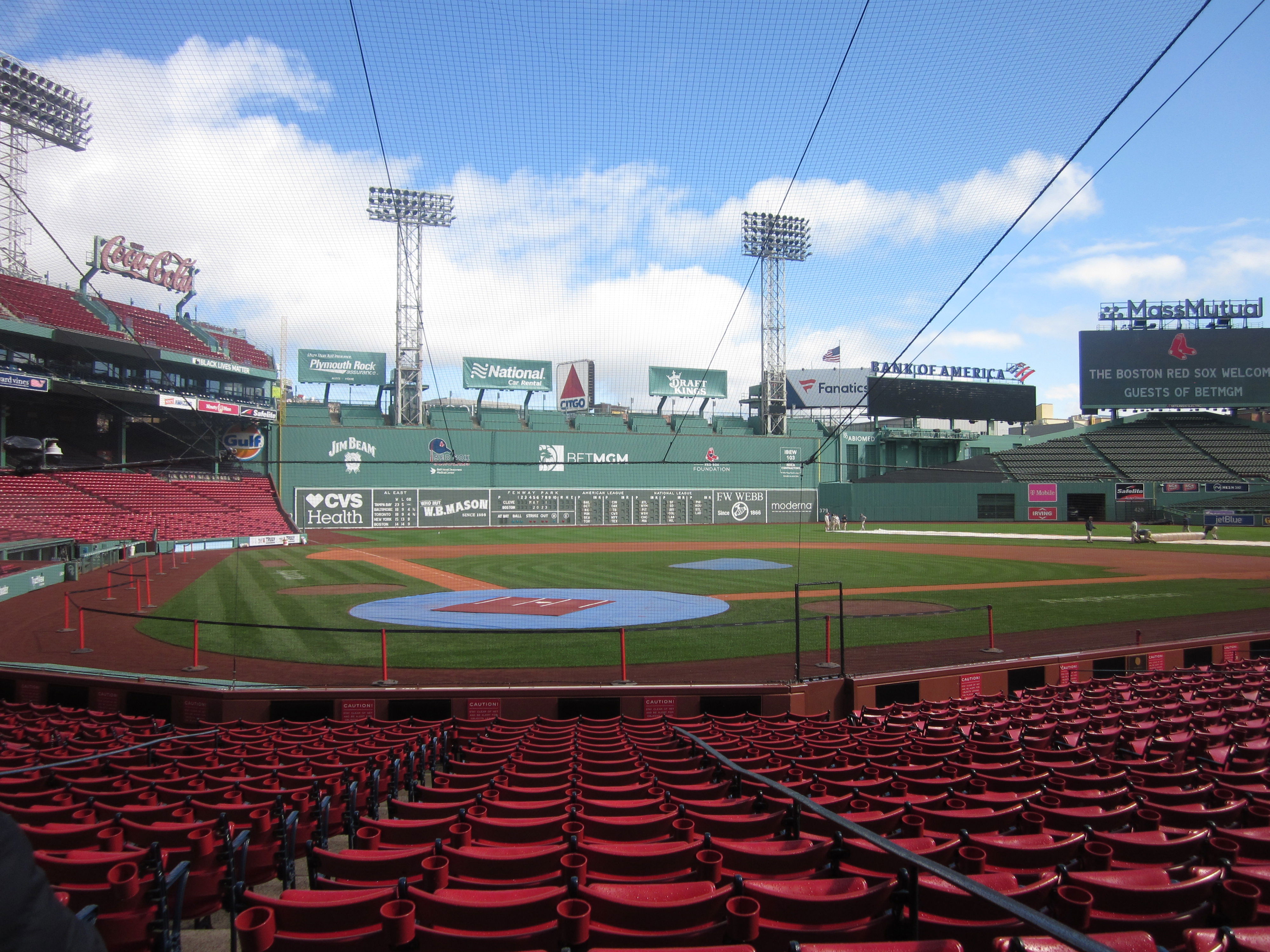
Baseball is a religion in towns and cities across the United States and Boston has one of the oldest teams in existence. The other two are the New York Yankees and the St. Louis Cardinals. Fenway Park is known as the America’s most beloved ball park. However, it religious connotation is “the cathedral of baseball”. After its inception in 1911, Boston won the so-called World Series back to back from 1914 to 1918, thanks in no small measure to the contribution as both pitcher and hitter of one George Hermann Ruth, better known as “The Babe” or “Bambino” or the “Sultan of Swat”. Unfortunately his hard-drinking, fighting and bad attitude made him increasingly unpopular with the management who then proceeded to sell the player and several others to none other than their rivals, the New York Yankees. Ironically, this ensured that the World Series titles were dominated by the Bronx based team throughout the 1920s. It would not be until 2004,, that the Red Sox would once again claim the World Series for themselves. Since then, they have won the accolade a further 3 times, 2018 being the last.
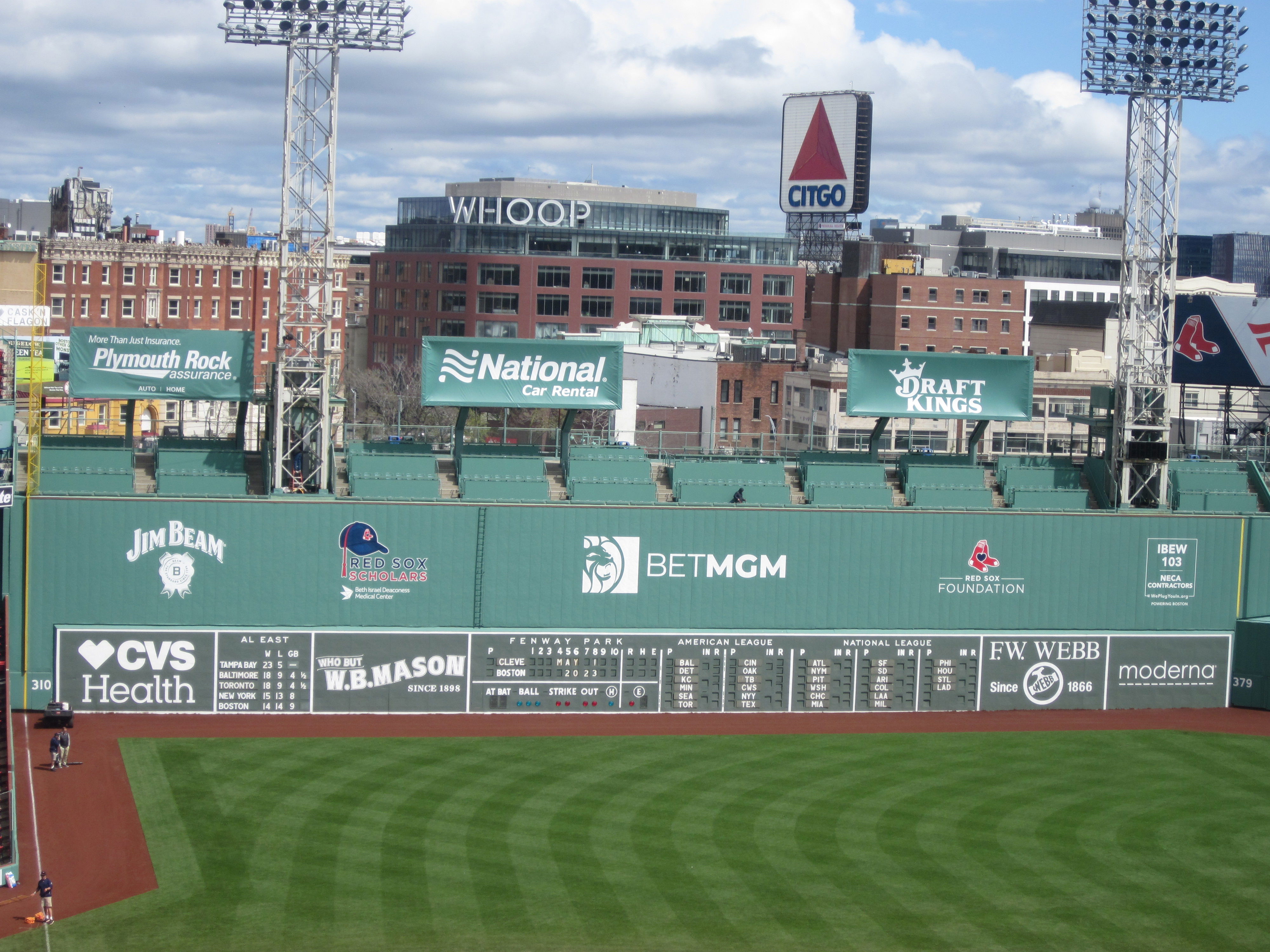
Now you may wonder where my interest and indeed knowledge of baseball comes from. Well, back when I was still at university, I decided to spend my summer holiday working in the USA and to use the money accumulated to finance some sightseeing thereafter. My job took me to an amusement park in the Massachusetts town of Agawam, near the city of Springfield, roughly 150km from Boston. Then only an independent concern, nowadays it is part of the Six Flags Amusement park franchise, the largest in the world. Whenever we had some days off, I and several other students from England, Scotland and Wales would take off to places near and far. This took me first to the Basketball Hall of Fame in Springfield and next to a baseball game between the Boston Red Sox and none other than the New York Yankees. It was a Saturday, the date was 13th May and the Sox were recovering from a humiliating defeat the night before. The game was so electrifying that it left a lasting impression on me. After than time, whenever I visited the States, I have made sure to watch at least one baseball game live. I have watched the San Diego Padres play at Petco Park, the San Francisco Giants play at AT&T Park and the Chicago Cubs play at Wrigley Field, not forgetting the Los Angeles Angels playing at Anaheim. It is fair to say that I have followed the game ever since and each time, it is an experience like no other.
Those not familiar with baseball can find the rules here:: https://www.rulesofsport.com/sports/baseball.html
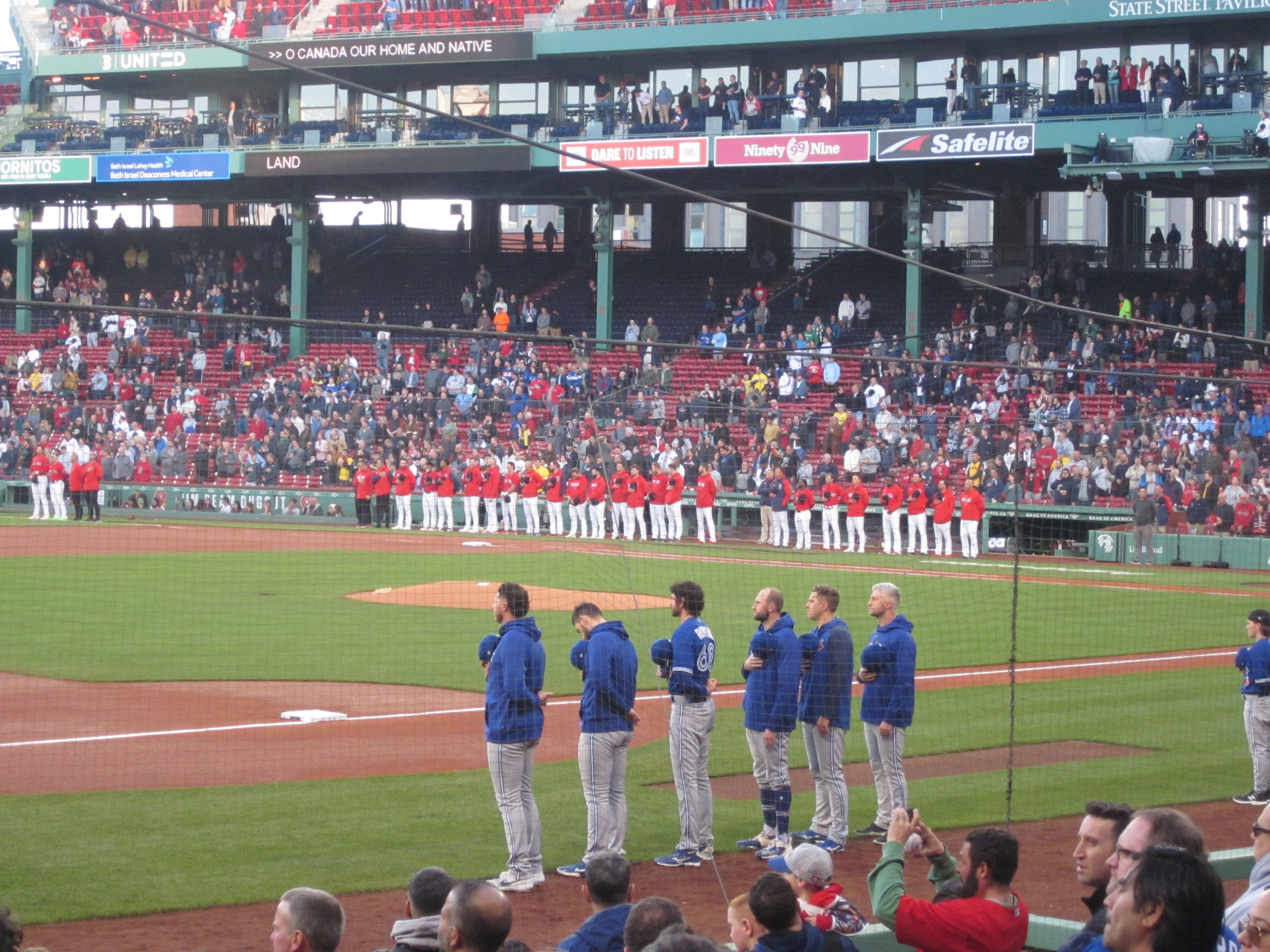
Before each game begins, the crowd rises and in full voice and with the right hand firmly covering the heart, sings the Star Spangled Banner, America”s national anthem. This is then followed by an introduction to the main players on both teams, their batting average and their positions on the baseball diamond. The visiting team is always the first to start. Both teams’ players take it in turns to warm up and stretch their legs before the game starts and between the individual innings begin. This enables them to make some truly acrobatic catches, the likes of which are hard to describe in print.
That night, I got my ticket from the main gate, picked up my commemorative cup from the concession stand and enjoyed the night with th occasional Hot Dog and a slice of pizza. It was end to end stuff, with the guests, the Totonto Blue Jays taking an early lead but ultimately being defeated in the final inning as the Sox won 6-5. What a night it had been and so feeling fully happy with my time in Boston I made my way back to the hotel to pack my bags for stage two of my epic adventure. Time to take a bite out of the Big Apple, so to get there I boarded the Amtrak “Acela”.